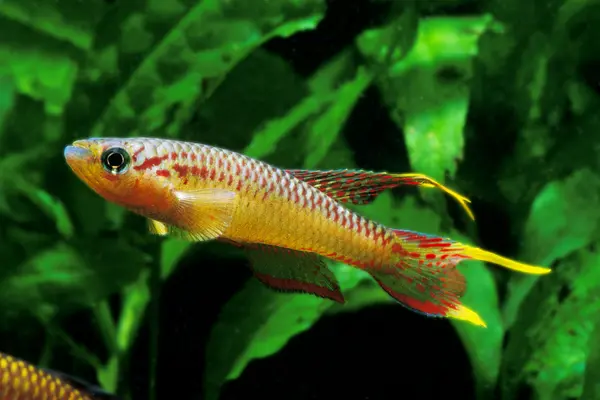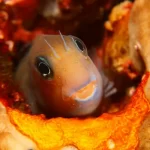Killifish are effectively probably the most bizarre fish also – a few animal species are male and female simultaneously. Some can endure a long time out of the water, while others even reproduce in lakes and streams that evaporate for a part of the year.
Killifish are definitely worth your consideration yet you’ll have to do a touch of examination and chase around to track down them. Specialty aquarium stores might convey them, yet placing a request in is the safest bet.
Everything You Need to Know About Killifish – Killifish Details

Killifish arrive in many colors and designs, and they’re all very beautiful. These freshwater fish make a fabulous extension to your aquarium.
They are not just great tank mates who coexist with most fish, however, they are additionally genuinely direct to take care of. We plan to show you all that you want to realize about Killifish in this article so you might turn into a Killifish master!
We’ll go over all you want to be aware of Killifish, including how to really take care of them, their eating routine, and aquarium necessities, in addition to other things.
Killifish Overview
| Family: | Cyprinodontiformes |
| Origin: | Canada, Americas, Argentina, Asia, Europe |
| Temperament: | Most species are peaceful |
| Size: | 2-9 CM |
| Minimum Tank Size: | 20 Gallons per pair |
| Diet: | Carnivore |
| Care: | Easy-Difficult (species dependent) |
Killifish are splendidly colored freshwater fish that have a place in the Cyprinodontidae family. Swordtails, guppies, platies, and molly fish are far-off family members.
They include wonderful examples and varieties that are incredibly distinctive. Their fierce-sounding name might switch certain individuals off, yet they are not even close to dangerous. Killifish are very amicable.
The name killifish comes from the Dutch expression ‘killi’, which connects with the killifish’s lean toward an environment of calm streams, low-lying channels, or inside a trench.
Killifish are predominantly tracked down in shallow subtropical and tropical waters.
They occupy both still and moving waters, and are for the most part freshwater fish. Nonetheless, there are a couple of animal varieties that likewise live in saline and salt water.
Right at their natural habitat, some killifish (Annual Killies) have a life expectancy that just goes on for a couple of months.
Albeit the term ‘killi’ seems like it very well may be risky, killifish didn’t determine their name for the same reason. ‘Killy’ is really gotten from the Dutch word that means trench or channel.
By far, most killifishes are only a couple of inches in size, with bigger species arriving at up to six inches.
Compatibility and Behavior
Most killifish are tranquil and manage everything well in local area tanks; be that as it may, the guys can be forceful towards one another.
Therefore, in the event that you’re a beginner, we suggest you keep a couple of killies in a tank only made for these species.
Notwithstanding, if you are capable and need to keep a gathering of killies in a bigger tank, you can do such as long as you give a lot of retreats and spaces for revealing.
On the other hand, you can simply have one male killifish in every aquarium, and abstain from keeping any comparable-looking male species.
You can hold quite a few females together.
Killies are generally great local area fish and can be kept with other little, serene species that require comparative water conditions, like neon tetras and rummy nose tetras.
There is one quality of killies behavior that is VITAL that you know about while setting up your tank – practically every one of them are mind-boggling jumpers!
Consequently, you ought to ensure you cover your tank with a hood and guarantee its security. Given the small size of killies, they can go through tiny holes.
Appearance
Killifish change generally for all intents and purposes. One thing the vast majority of them in all actuality do share practically speaking however is the splendid varieties and clear patterns.
The males are a lot more splendid than the females, and most killies’ heads are level at the top. Their mouths are at the tip of their face or under and their teeth are for quite some time, bent, and pointed.
Most killifish are thin and pike molded, which makes them extraordinary swimmers. Some have a more roundly formed body with short adjusted blades and others have long expansive balances.
The body shape differs relying upon the species, yet they all have a dorsal balance set towards the back portion of their body. In many species, males likewise have bigger dorsal and anal blades.
As referenced previously, most killifish are somewhere in the range of one and four inches.
An outrageous illustration of a bigger killifish is The Orestias (Orestias cuvieri) which can grow up to ten and a half inches.
Aquarium Requirements
This part will give an overall outline of killifish tank conditions. Perusing this guidance close to unambiguous species advice is significant.
In the wild, killifish occupy an immense scope of spots, most killifish are likewise very strong thus, in this way, repeating their regular settings into a tank setting is surprisingly straightforward.
The tank size and arrangement will rely heavily on the number of fish you need to keep and what your explanations behind keeping them are.
Whether you keep your killies in saltwater or a freshwater tank will likewise rely upon the species.
Tank Conditions
The water states of your tank rely completely upon the types of killifish which will occupy it.
Most of the killifish require water temperatures of 72-75oF, in the event that you have recently a solitary tank, you can utilize a normal aquarium warmer, in any case, more serious killifish guardians who have a room loaded with tanks may rather warm the entire room.
The pH balance is different in every Killifish tank in light of the fact that every single Killie has an alternate inclination. For instance, some come from delicate acidic waters and others occupy hard basic waters.
Tank Setup
A 20-gallon tank is ideal for an ordinary set of killifish, but in case you are settling on one of the bigger animal types you should change your tank size likewise.
Most killies ought to be in a long shallow tank with very little, or no water development. Your tank ought to have a lot of live plants, basically drifting plants.
Plants that are appropriate incorporate the cryptocorynes. This is on the grounds that they truly do well with low degrees of lighting.
The tank can be uncovered on the floor, however, the vast majority like to cover it with dull rock. Assuming that you truly do decide to utilize rock, you ought to pick a sort that won’t solidify the water.
Diet
Killifish are for the most part carnivores, and right in their natural habitat, they eat scavengers, larvae of insects, and worms.
Some are omnivores and remember green growth for their diet.
In an aquarium, most killifish require live food sources, accordingly in the event that you can’t give live food, or are confident that you could possibly switch them over to chip food – they’re not the right fish for you.
A changed and even eating regimen is especially significant in the event that you are reproducing killifish. Consequently, a great deal of experienced aquarists decides to make their own food so they can meet the specific wholesome necessities of their fish.
The best food varieties for grown-up killifish include:
Brine Shrimp – effectively taken by most killies, great healthful source. You can likewise attempt frozen brine shrimp.
Daphnia – most aquarists utilize this live food. It tends to be refined or gathered from lakes (care should be taken not to gather different creatures or fish).
It ought not to be utilized as a select food source as too many can go about as a purgative.
Mosquito Larvae – just accessible occasionally, can be gathered from lakes.
Breeding
Killifish are quite simple to raise, and this is maybe the top explanation that they are so well known with Aquarists and have such an immense fan base.
To raise killifish, it’s critical to realize that there are two distinct reproductive sorts.
Annual Killifish
Right at its natural habitat, the yearly killifish lives in a non-super durable waterway that dries out every year killing the fish.
Hence these fish have adjusted to develop and arrive at sexual maturity age very rapidly, generally within half a month. They lay their eggs in the peat greenery and they hatch when the water returns.
In the aquarium climate, they will require a little breeding tank with sand or a peat greenery substrate where they can cover their eggs.
When the eggs have been laid, the water and the guardians ought to be eliminated and the substrate ought to be saved warm and damp for about 90 days.
Where should you purchase Killifish?
As we referenced early, it’s uncommon to track down killifish available to be purchased in customary fish or pet stores, and on the off chance that they in all actuality do stock them, they will typically just have a couple of animal groups.
The vast majority purchase their killifish on the web, from reproducers and specialists, or at auctions.
At the point when you purchase your killifish, you ought to pick sound-looking fish, and furthermore guarantee they match the portrayal of the species you are picking.
Numerous types of killies can appear to be comparable, and some are misidentified in pet stores.
It’s critical to know precisely the exact thing you’re purchasing so you can give the right tank conditions to your fish.







